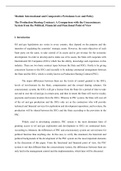Module: International and Comparative Petroleum Law and Policy
The Production Sharing Contract: A Comparison with the Concessionary
System from the Political, Financial and Functional Point of View
I. Introduction
Oil and gas legislations are varies in every country, they depend on the purpose and the
intention of regulating the countries’ strategic assets. However, the main objectives of each
State party are the same, to take control of its assets and to get revenue for the economic
development. In order to develop and to make use of its assets, the State will cooperate with
International Oil Companies (IOCs) which has the ability, knowledge and experience in this
industry. There are two basic contract types between the State and IOCs. Firstly is by giving
concession licenses to the IOCs and secondly is by making contractual arrangement between
the State and the IOCs, which is widely known as Production Sharing Contract (PSC).
The major differences between them are the levels of control granted to the IOCs,
levels of involvement by the State, compensation and the reward sharing schemes. On
concessionary system, the IOCs will get a license from the State for a period of time to take
out and to own the oil and gas in certain area, and then in return the State will receive royalty
payments and income taxation from the IOCs. Whereas in PSC system, the State will own all
of the oil and gas production and the IOCs only act as the contractors who will provide
technical and financial services for exploration and development operations, and in return, the
production will be shared between the IOCs and the State according to the provision in the
PSC.
Widely used in developing countries, PSC system is the most dominant form of
granting access to oil and gas exploration and development to IOCs on contractual basis.
According to Johnston, the differences of PSC and concessionary system are served more for
political function than anything else. In this case, to verify this statement, the historical and
political backgrounds of the development of the PSC system are the most important elements
in the discussion of this paper. From the functional and financial point of view, the PSC
system is not that different than the concessionary system, the differences between them are
only laid in the management control and the implementation, which later will be discussed.
, II. Historical and Political Backgrounds of PSC
PSC, introduced in Indonesia in year 1966, was created under the influence of nationalistic
feelings after its independence from Dutch colonialism. After its independence many foreign
companies’ concessions were expropriated for nationalisation, and there were no new oil
concession given by the government. In the meantime, the Indonesian people did not have the
ability and financial support to develop these assets, therefore there was stagnation in the oil
and gas development. This condition caused disadvantages for both the country, due the fact
that the new born country needed income to recover and to develop its economy, and IOCs
intended to invest their assets in Indonesia.
In order to overcome this situation, in 1960 a new regulation in oil and gas was enacted under
the spirit of Article 33 of the 1945 Indonesian Constitution which emphasizes that "Land,
water and their containing natural resources are possessed by the State and are used for
people's utmost wellbeing". Under the Government Decree No. 44/1960, oil and gas
exploration and exploitation were the responsibility of the State, and this responsibility was
delegated to the National Oil Company (NOC), which then cooperate with IOCs. At first, the
existing concessions were turned into contracts of work which was made between the NOC
now known as Perusahaan Pertambangan Minyak dan Gas Bumi Negara (Pertamina) and
IOCs. Yet, many people still criticized that it was considered as the same system in a
different form.
This issue was finally resolved by the introduction of PSC. PSC allows government to take
control of the State’s natural assets and Pertamina as the NOC had full managerial control. In
brief, the main principles of the first generation PSC are:
(a) Pertamina is responsible for the management of petroleum operations. The IOC (as the
Contractor) is responsible to Pertamina for the execution of the operations and
provides the necessary funds. As Pertamina held the management for the operation,
the Contractor would have to consult with Pertamina and seek its approval on certain
operational decisions including the Work Program and budget, plan of development
and exploration program. This clause is intended to create a long term sustainable
development for the country, and one of the driving forces of PSC is to learn and
master the petroleum business. This system, called ‘approval-process-cum-learning-





